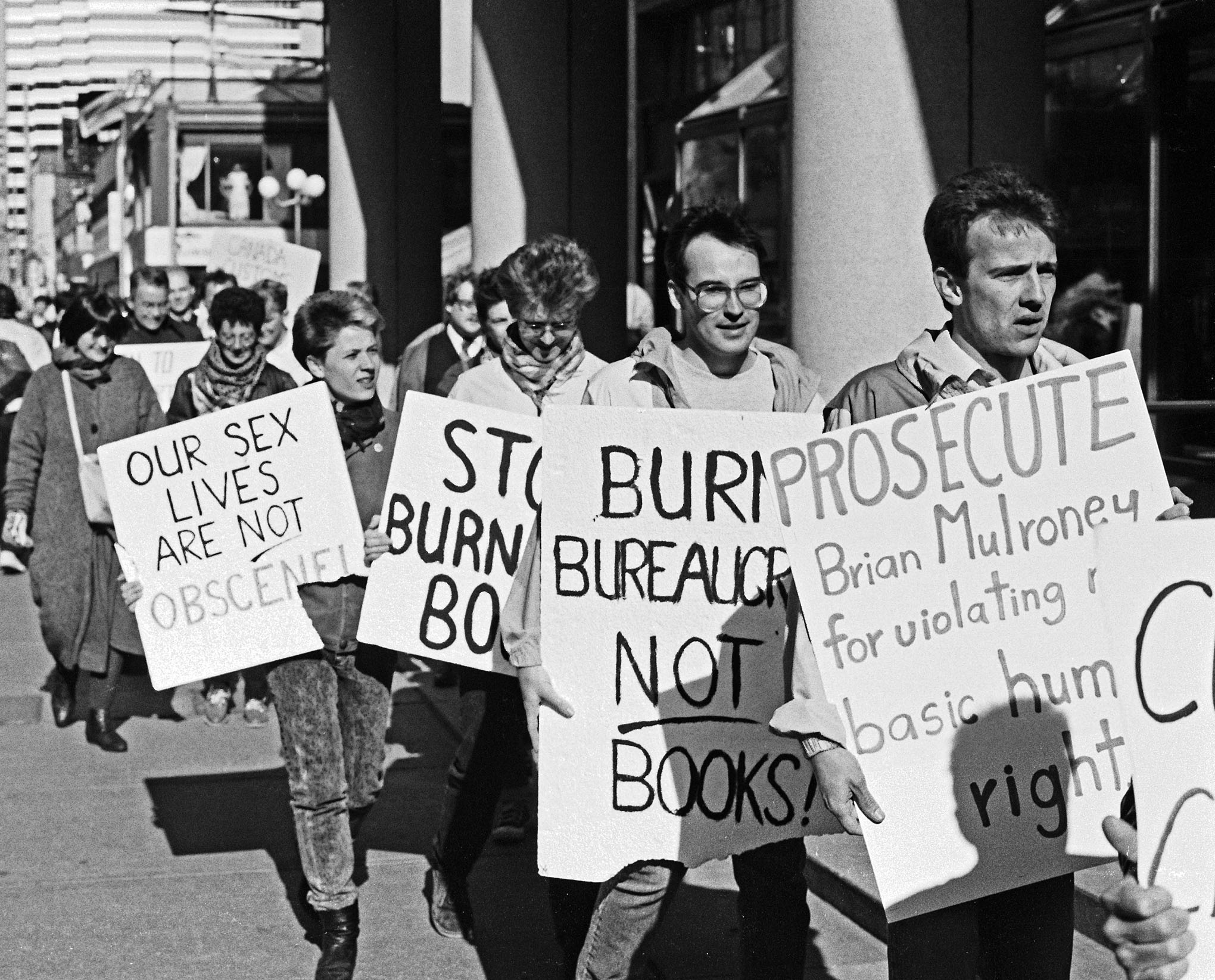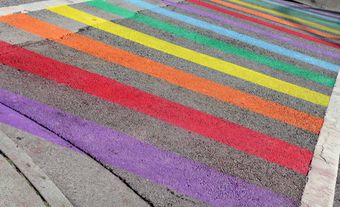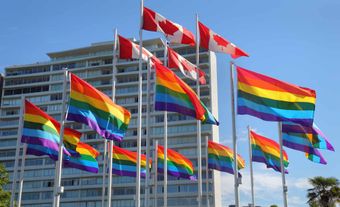The following article is part of an exhibit. Past exhibits are not updated.
The first Pride celebration held in Toronto was just three years after the Stonewall Riots in New York in June 1969, an event that sparked the gay liberation movement, and was a fairly modest affair — a picnic on the Toronto Islands.
Within a few years, thousands were attending the annual Gay Pride parade, and by 2011 more than 1.2 million attended Pride Toronto. At WorldPride 2014 in Toronto, the fourth WorldPride and the first in North America, an even larger crowd gathered.
A lot has happened in the years since the Stonewall Riots. The lesbian, gay, bisexual and transgender (LGBT) community in Canada has made major strides toward mainstream acceptance and legal equality, with notable progress in health care, the right to adopt, and the right to marry. In addition, LGBT artists have risen to the forefront of contemporary culture, from literature and the visual arts to theatre and film.
In celebration of pride, The Canadian Encyclopedia has assembled an exhibit of articles on related issues, including a history of LGBT rights in Canada, a memoir of the queer theatre scene in Toronto by acclaimed playwright Sky Gilbert, a history of queer culture in Canada and an article exploring transgender people and the Canadian health care system.
Gay Liberation in the 1970s

While discrimination against LGBT people persists in many places, major strides toward mainstream social acceptance and formal legal equality have nonetheless been made in recent decades. Canada is internationally regarded as a leader in this field. Recent years have seen steady progress on everything from health care to the right to adopt. In 2005, Canada became the fourth country worldwide to legalize same-sex marriage.
The modern gay liberation movement in North America began in the summer of 1969 with New York City’s unprecedented Stonewall Riots, which took place in the early morning of 28 June. The New York Police Department had attempted a raid on a popular gay bar in the heart of Greenwich Village that night, but the bar’s patrons fought back forcefully, resulting in a humiliating defeat for the police and garnering nation-wide media attention. On the first anniversary of the riots, marches took place in New York, Boston, Minneapolis, Chicago, San Francisco and Los Angeles.
The movement simultaneously gained momentum in Canada. In August 1971, the first protests for gay rights took place with small demonstrations in Ottawa and Vancouver demanding an end to all forms of state discrimination against gays and lesbians. One year later, Toronto held its first Pride celebration with a picnic on the Toronto Islands organized by the University of Toronto Homophile Association, Toronto Gay Action Now and the Community Homophile Association of Toronto.
The early 1970s also saw the emergence of Canada's first gay publication, The Body Politic, established in Toronto in 1971 and published until 1987. Today, its publisher, Pink Triangle Press, puts out Daily Xtra, with editions in Toronto, Ottawa and Vancouver. Pink Triangle Press also founded the Canadian Lesbian and Gay Archives in 1973, which today is a respected and historically important collection of LGBT material.
The 1980s

On 5 February 1981, Toronto police arrested almost 300 men in raids on four bathhouses. The following day, a crowd of 3,000 people took to the streets and marched on 52 Division police precinct and Queen’s Park, smashing car windows and setting fires en route.
The men were charged with being “found-ins” in a bawdy-house, which police defined as being any location where “indecent acts” took place. The vast majority of the charges were thrown out. Such raids continued over the next 20 years in Canada, including a 2002 raid on a Calgary bathhouse. In Toronto, where the relationship with police was particularly fraught, the raids culminated in a police sweep of the Pussy Palace, a women-only event, in 2000. Charges were dismissed, and the resulting lawsuit led to the development of training programs for Toronto police on interacting with the LGBT community.
The 1981 raids led to the establishment of Lesbian and Gay Pride Day in Toronto, which attracted 1,500 participants that same year. (The City of Toronto did not endorse Pride until 1991.) Since then, Pride has been held annually in Toronto and several cities across the country.
The HIV/AIDS Crisis

The 1980s also saw the emergence of the HIV/AIDS epidemic in Canada, which would have a devastating impact on the gay community. Throughout the decade, gay men felt that their health was being ignored by the medical establishment and the government and increasingly took matters into their own hands.
As the crisis escalated, the movement became more organized and politically proactive. In 1983, AIDS Vancouver became Canada's first AIDS service organization, offering care to those with HIV or AIDS. The same year, in Toronto, Gays in Health Care, the Hassle Free Clinic and The Body Politic united to form the Toronto AIDS Committee, soon renamed the AIDS Committee of Toronto. Another watershed moment came in 1988, with the establishment of AIDS Action Now (AAN), a group that adopted direct action as a means of pressuring governments to take meaningful steps to address the crisis.
The first AAN action was a protest against a Toronto drug trial for Pentamidine, a drug already approved for American AIDS patients. AAN brought coffins to the Toronto General Hospital where the research was taking place, demanding that the drug be made immediately available. The protests were successful, and within two years the government of Brian Mulroney implemented a program granting access to experimental drugs and the launch of the first national AIDS strategy.
The 1990s and 2000s

As gays and lesbians were increasingly represented in the public sphere, these changes reflected the community’s continued and growing acceptance into mainstream Canadian culture.
Several of these victories were won in the courts. Among them was a 1992 federal court ruling that lifted the ban on gays and lesbians in military; a 1994 Supreme Court ruling that gays and lesbians could apply for refugee status on the basis of facing persecution in their countries of origin; and a 1995 ruling in Ontario that allowed same-sex couples to adopt.
In 1999, the Supreme Court ruled in a case known as M v. H that same-sex couples must be afforded the same rights as opposite-sex couples in a common-law relationship. In 2000, the federal government passed Bill C-23, which brought federal statutes into line with the ruling.
Much of the early 2000’s news for LGBT Canadians revolved around the issue of same-sex marriage. In 2002, the Ontario Superior Court ruled that prohibiting same-sex marriage was a violation of Charter rights. The ruling was followed in 2003 by a similar ruling in British Columbia. In 2003, the Ontario Court of Appeal upheld the ruling, and Michael Leshner and Michael Stark became the first same-sex couple to marry in Canada.
By 2005, Nunavut, the Northwest Territories, Alberta and PEI were the only jurisdictions not allowing same-sex marriage. On 20 July of that year, Bill C-38 became federal law, making Canada the fourth country in the world to allow same-sex marriage.
In 2008, Canada increased the age of sexual consent from 14 to 16. The age of consent for anal sex, however, remains at 18, leading to charges of discrimination against gay youth.
The 2010s and Beyond

The rights of trans people in Canada continue to be at the forefront of the struggle for equality. Currently, the only provinces that explicitly include gender identity under their human rights codes are Ontario, Manitoba, Nova Scotia and the Northwest Territories, although other provinces have ruled that it is a protected ground under existing legislation. Federally, gender identity is not specifically mentioned in legislation. Bill C-279, which would amend the Canadian Human Rights Act to include gender expression or identity, is currently undergoing second reading in the Senate.
Trangender activists have also fought to make it easier to change their gender on official documents, without having to have actually undergone gender reassignment surgery. Ontario's Human Rights Tribunal struck down the surgical provision in 2012, the BC legislature and an Alberta court followed suit in 2014. The Manitoba government has expressed a similar intention.
With the steady increase in rights for LGBT Canadians, the focus of many has turned to the situation of gays and lesbians abroad who face more violent persecution. Such cases have become a focus for many of today's Pride celebrations. This culminated in 2014, when Toronto hosted the fourth WorldPride Event, which included a week-long human rights conference.
As Pride celebrations kick off across the country, Leah and Falen shout out the Gay Asians of Toronto (GAT). Formed in 1979, this organization is thought to be the first LGBT group for non-white queer people in Canada.Note: The Secret Life of Canada is hosted and written by Falen Johnson and Leah Simone Bowen and is a CBC original podcast independent of The Canadian Encyclopedia.

 Share on Facebook
Share on Facebook Share on X
Share on X Share by Email
Share by Email Share on Google Classroom
Share on Google Classroom


